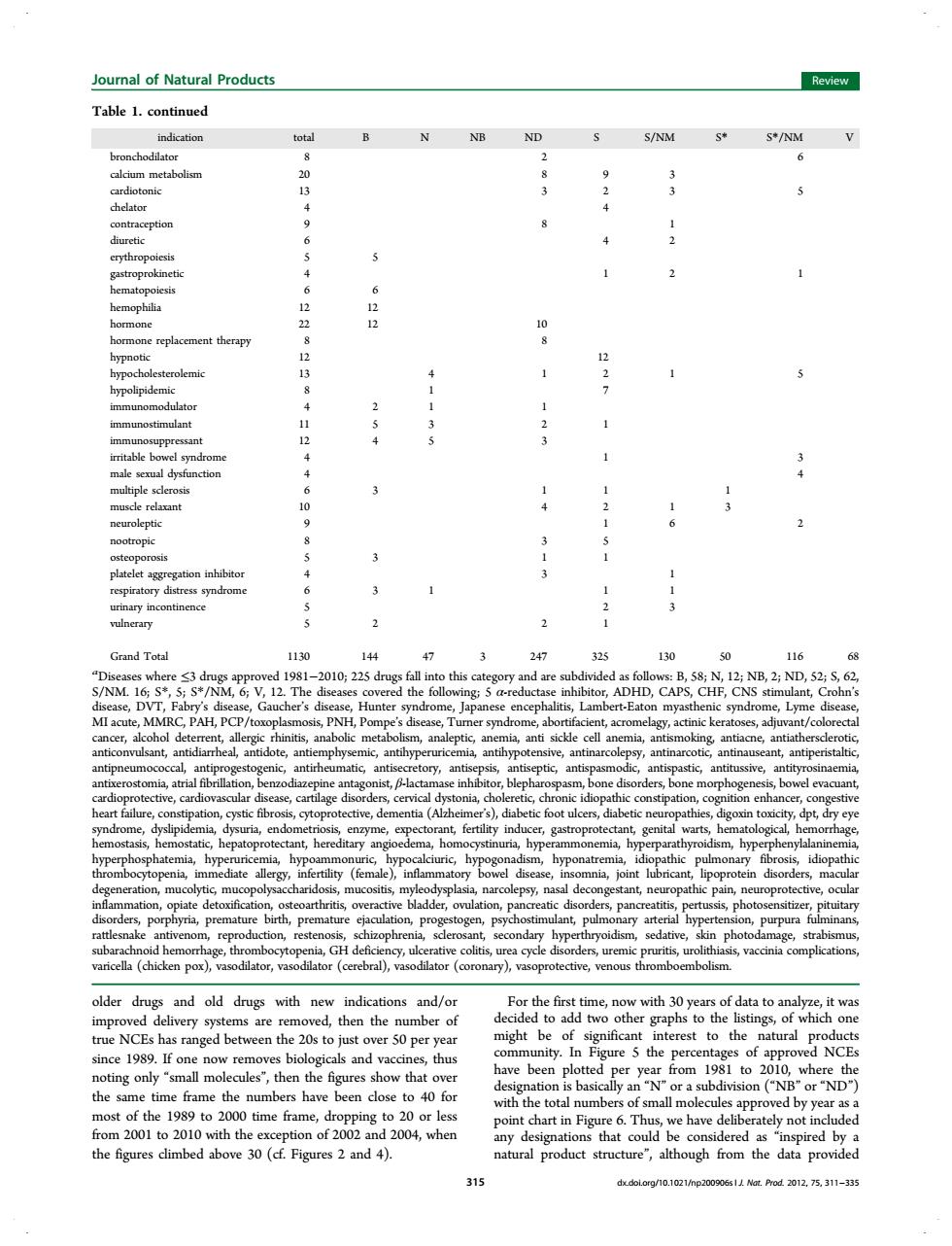正在加载图片...

Joumnal of Natural Products Review Table 1.continued rand Tot 10 144 10 0102 2i NB. h ra).t and old with nev on and/o hasanged between the 20s to just over so per yea might b fnw est to the s the atural pro ince 1989.If one now rer s biologicals and vaccir thu ting only then the ow tha d per year rom 2001 to 2010 with the exception of 2002 and 2004.when tely not include the figures climbed above 30(cf.Figures 2 and 4). 1 g/h0.10z1p20o90s1god2012.75,311-35 older drugs and old drugs with new indications and/or improved delivery systems are removed, then the number of true NCEs has ranged between the 20s to just over 50 per year since 1989. If one now removes biologicals and vaccines, thus noting only “small molecules”, then the figures show that over the same time frame the numbers have been close to 40 for most of the 1989 to 2000 time frame, dropping to 20 or less from 2001 to 2010 with the exception of 2002 and 2004, when the figures climbed above 30 (cf. Figures 2 and 4). For the first time, now with 30 years of data to analyze, it was decided to add two other graphs to the listings, of which one might be of significant interest to the natural products community. In Figure 5 the percentages of approved NCEs have been plotted per year from 1981 to 2010, where the designation is basically an “N” or a subdivision (“NB” or “ND”) with the total numbers of small molecules approved by year as a point chart in Figure 6. Thus, we have deliberately not included any designations that could be considered as “inspired by a natural product structure”, although from the data provided Table 1. continued indication total B N NB ND S S/NM S* S*/NM V bronchodilator 8 2 6 calcium metabolism 20 8 9 3 cardiotonic 13 3 2 3 5 chelator 4 4 contraception 9 8 1 diuretic 6 4 2 erythropoiesis 5 5 gastroprokinetic 4 1 2 1 hematopoiesis 6 6 hemophilia 12 12 hormone 22 12 10 hormone replacement therapy 8 8 hypnotic 12 12 hypocholesterolemic 13 4 1 2 1 5 hypolipidemic 8 1 7 immunomodulator 4 2 1 1 immunostimulant 11 5 3 2 1 immunosuppressant 12 4 5 3 irritable bowel syndrome 4 1 3 male sexual dysfunction 4 4 multiple sclerosis 6 3 1 1 1 muscle relaxant 10 4 2 1 3 neuroleptic 9 1 6 2 nootropic 8 3 5 osteoporosis 5 3 1 1 platelet aggregation inhibitor 4 3 1 respiratory distress syndrome 6 3 1 1 1 urinary incontinence 5 2 3 vulnerary 5 2 2 1 Grand Total 1130 144 47 3 247 325 130 50 116 68 a Diseases where ≤3 drugs approved 1981−2010; 225 drugs fall into this category and are subdivided as follows: B, 58; N, 12; NB, 2; ND, 52; S, 62, S/NM. 16; S*, 5; S*/NM, 6; V, 12. The diseases covered the following; 5 α-reductase inhibitor, ADHD, CAPS, CHF, CNS stimulant, Crohn’s disease, DVT, Fabry’s disease, Gaucher’s disease, Hunter syndrome, Japanese encephalitis, Lambert-Eaton myasthenic syndrome, Lyme disease, MI acute, MMRC, PAH, PCP/toxoplasmosis, PNH, Pompe’s disease, Turner syndrome, abortifacient, acromelagy, actinic keratoses, adjuvant/colorectal cancer, alcohol deterrent, allergic rhinitis, anabolic metabolism, analeptic, anemia, anti sickle cell anemia, antismoking, antiacne, antiathersclerotic, anticonvulsant, antidiarrheal, antidote, antiemphysemic, antihyperuricemia, antihypotensive, antinarcolepsy, antinarcotic, antinauseant, antiperistaltic, antipneumococcal, antiprogestogenic, antirheumatic, antisecretory, antisepsis, antiseptic, antispasmodic, antispastic, antitussive, antityrosinaemia, antixerostomia, atrial fibrillation, benzodiazepine antagonist, β-lactamase inhibitor, blepharospasm, bone disorders, bone morphogenesis, bowel evacuant, cardioprotective, cardiovascular disease, cartilage disorders, cervical dystonia, choleretic, chronic idiopathic constipation, cognition enhancer, congestive heart failure, constipation, cystic fibrosis, cytoprotective, dementia (Alzheimer’s), diabetic foot ulcers, diabetic neuropathies, digoxin toxicity, dpt, dry eye syndrome, dyslipidemia, dysuria, endometriosis, enzyme, expectorant, fertility inducer, gastroprotectant, genital warts, hematological, hemorrhage, hemostasis, hemostatic, hepatoprotectant, hereditary angioedema, homocystinuria, hyperammonemia, hyperparathyroidism, hyperphenylalaninemia, hyperphosphatemia, hyperuricemia, hypoammonuric, hypocalciuric, hypogonadism, hyponatremia, idiopathic pulmonary fibrosis, idiopathic thrombocytopenia, immediate allergy, infertility (female), inflammatory bowel disease, insomnia, joint lubricant, lipoprotein disorders, macular degeneration, mucolytic, mucopolysaccharidosis, mucositis, myleodysplasia, narcolepsy, nasal decongestant, neuropathic pain, neuroprotective, ocular inflammation, opiate detoxification, osteoarthritis, overactive bladder, ovulation, pancreatic disorders, pancreatitis, pertussis, photosensitizer, pituitary disorders, porphyria, premature birth, premature ejaculation, progestogen, psychostimulant, pulmonary arterial hypertension, purpura fulminans, rattlesnake antivenom, reproduction, restenosis, schizophrenia, sclerosant, secondary hyperthryoidism, sedative, skin photodamage, strabismus, subarachnoid hemorrhage, thrombocytopenia, GH deficiency, ulcerative colitis, urea cycle disorders, uremic pruritis, urolithiasis, vaccinia complications, varicella (chicken pox), vasodilator, vasodilator (cerebral), vasodilator (coronary), vasoprotective, venous thromboembolism. Journal of Natural Products Review 315 dx.doi.org/10.1021/np200906s | J. Nat. Prod. 2012, 75, 311−335